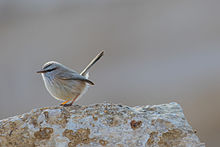Streaked scrub warbler
| Streaked scrub warbler | |
|---|---|

| |
| Sde Boker, Palestine | |
| Scientific classification | |
| Domain: | Eukaryota |
| Kingdom: | Animalia |
| Phylum: | Chordata |
| Class: | Aves |
| Order: | Passeriformes |
| Family: | Scotocercidae Fregin, Haase, Olsson, & Alström, 2012 |
| Genus: | Scotocerca Sundevall, 1872 |
| Species: | S. inquieta
|
| Binomial name | |
| Scotocerca inquieta (Cretzschmar, 1830)
| |
The streaked scrub warbler (Scotocerca inquieta), also known simply as the scrub warbler, is a small passerine bird. It is the only species placed in the genus Scotocerca. It is found in northern Africa and south-western Asia. It is a bird of desert fringes, frequenting scrubby areas, ravines and gorges, and is mainly resident, although local movements can occur outside the breeding season.[2]
The genus is placed in its own
Taxonomy
The streaked scrub warbler was
The streaked scrub warbler was formerly sometimes placed in the family
Eight subspecies are recognised:[6]
- S. i. theresae Meinertzhagen R, 1939 – Mauritania, southwest and central Morocco
- S. i. saharae (Loche, 1858) – east Morocco to Libya
- S. i. inquieta (Cretzschmar, 1830) – northeast Egypt to northwest Arabia
- S. i. grisea Bates, 1936 – west Saudi Arabia, east Yemen and Oman
- S. i. buryi Ogilvie-Grant, 1902 – south Saudi Arabia and west Yemen
- S. i. montana Stepanyan, 1970 – Iran, south Turkmenistan, south Tajikistan and Afghanistan
- S. i. platyura (Severtsov, 1873) – Kazakhstan, Uzbekistan, north Turkmenistan and southwest Tajikistan
- S. i. striata (Brooks W.E., 1872) – south-central Iraq, south Iran and Pakistan
Some authorities split the streaked scrub warbler into two species, the Saharan scrub warbler (Scotocerca saharae, including subspecies theresae) and the Levant scrub warbler (Scotocerca inquieta, including all other subspecies), an approach which has been followed in the most recent version of the Collins Bird Guide.[11]
| |||||||||||||||||||||||||||||||||||||||
| Cladogram showing the family relationships based on a study by Carl Oliveros and colleagues published in 2019. International Ornithological Committee (IOC).[6]
|
Description
The streaked scrub warbler is a small, skulking desert warbler which cocks its tail over its back. The adults are grey brown above, finely streaked with dark brown. They have a broad pale supercilium and a thin black eyestripe. The underparts are whitish with reddish flanks and vent, the breast is finely streaked. The tail is graduated and dark brown with a white tip. Juveniles are duller.[13]
The song of the streaked scrub warbler is distinctive and is rendered as "zit-zit dweedle-doolredle-doleed"[13]
Distribution and habitat
The streaked scrub warbler is a bird of open desert with a sparse cover of scrub, especially wadi beds with a denser cover than the surrounding desert, as well as scree areas with bushes in ravines and gorges.[14]
Behaviour
Breeding
The streaked scrub warbler nests in low scrub up to 1.5m above the ground, the nest is a domed structure made of grass and twigs and lined with feathers, fur and plant down. It has 1-2 side entrances, and if there is a second it is used only as an exit. The clutch size averages 3–5 but varies from 2–5, incubation is roughly two weeks with another two weeks before the young fledge.
Food and feeding
Its main food is insects but it will also eat seeds which may be very important in winter. It forages on the ground, fossicking through leaf litter and other debris under bushes, and into cavities but will also feed up in the vegetation at times.[15]
Status
The streaked scrub warbler has a very wide range and is scarce in some places and common in others. No particular threats have been identified and the population is believed to be steady or declining slightly. The International Union for Conservation of Nature has rated its conservation status as being of "least concern".[1]
Gallery
-
Petra, Jordan
-
Sde Boker, Israel
-
Illustration by Henrik Grønvold (1909)
References
- ^ . Retrieved 12 November 2021.
- ^ "Streaked Scrub-warbler (Scotocerca inquieta)". HBW Alive. Lynx Edicions. Retrieved 27 November 2016.
- ^ Cretzschmar, Philipp Jakob (1826). "Vögel". In Rüppell, Eduard (ed.). Atlas zu der Reise im nördlichen Afrika (in German). Frankfurt am Main: Heinr. Ludw. Brönner. p. 55, Plate 36 Fig. b. Although 1826 is printed on the title page, the descriptions was not published until 1830.
- ^ Mayr, Ernst; Cottrell, G. William, eds. (1986). Check-List of Birds of the World. Vol. 11. Cambridge, Massachusetts: Museum of Comparative Zoology. p. 126.
- ^ Sundevall, Carl Jakob (1872). Methodi naturalis avium disponendarum tentamen. Försök till fogelklassens naturenliga uppställnung (in Latin, Swedish, and French). Stockholm: Samson & Wallin. p. 7.
- ^ Rasmussen, Pamela, eds. (July 2021). "IOC World Bird List Version 11.2". International Ornithologists' Union. Retrieved 9 December 2021.
- ISBN 978-1-4081-2501-4.
- PMC 3462691.
- .
- ISBN 978-84-941892-0-3.
- ^ "Collins Bird Guide - special offer on revised hardback edition". Rare Bird Alert. 28 May 2015. Retrieved 9 April 2019.
- PMID 30936315.
- ^ ISBN 0-7136-3959-8.
- ISBN 0-7136-3960-1.
- ISBN 0-19-850188-9.




